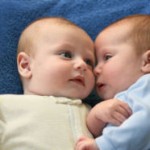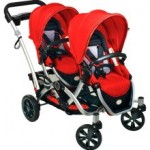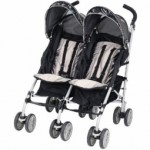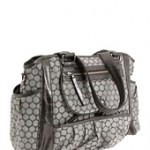The twins will arrives soon, and you know you want to be completely prepared!
 Some parents prepare with just the basic needs, and some parents prepare for the arrival of their baby(ies) by purchasing every possible pricey item, gadget, and trendy must-have out there! For most of us in-betweeners, however, who know that the arrival of their twins will mean being sensibly prepared, here are a list of items that I found met all of our needs, three times around.
Some parents prepare with just the basic needs, and some parents prepare for the arrival of their baby(ies) by purchasing every possible pricey item, gadget, and trendy must-have out there! For most of us in-betweeners, however, who know that the arrival of their twins will mean being sensibly prepared, here are a list of items that I found met all of our needs, three times around.
Obviously, there are many varieties in terms of styles, features and price range, so I’m listing here the items from a general perspective. These aren’t in any particular order, just a checklist to refer to:
Vital Needs (Furniture/Equipment):
2 Cribs — Even if you co-bed your babies when their tiny, you’ll be surprised how soon they’ll need their own space!
1 Clothing bureau or dresser for folded clothing and blankets
2 Infant Car Seat Carriers — My favorite come with the snap in base for easy placement and removal from the car.
1 Double Stroller — These come in both front/back and side-by-side styles.
Pros and Cons of each style of stroller:
Front/Back: Advantages— ease in fitting through tight space. Disadvantages—Heavy, bulky, complicated to open and close, small and awkward to reach storage space beneath seats, and children will eventually kick each others’ seat and pull hair. I believe this is true because no one really likes riding in the back or backwards (in the case of the facing each other option in some front/back strollers).
Side/Side: Advantages—lightweight, easy to open and close, generous and easy to access storage spaces under each seat, and babies/toddlers won’t conflict with each other as much side by side as they do front to back. Disadvantages—Oftentimes awkward maneuvering through tight fitting doorways, but most commercial structures have double doors or wide single doorways.
1-2 Baby Swings — In my book, this is a vital need if you plan to maintain your sanity some days.
2 High Chairs (or high chair/booster transition seats) with trays — They will be used as early as 4-5 months when solid foods are introduced. Many allow the seat to recline slightly for the baby who’s not sitting up yet.
2 Portable Cribs — “Pack ‘n Plays” are great for day or overnight trips for naps and night time because they fold down to (a bit heavy) but convenient to carry and pack. They also double as perfect bassinets since most styles feature a bassinet setting option.
2 Snugglies or Baby Slings for ease in baby toting.
1-2 Boppy Pillows for breast feeding or bottle feeding. There is an actual nursing pillow specifically designed for twins!
Not-so-vital furniture/equipment:
Changing table — Where you WILL need changing pads that can be placed on beds, couches, floor, etc., an actual table just for changing is optional. I never owned one, but these could come in handy if they were a combination changing table and dresser. Changing baby in a high place is much more dangerous than on a lower surface, so that may be a factor for you to consider.
Wipe warmer — I thought this would be a wonderful item to have so the wipe wasn’t so cold to baby’s skin. However, as soon as the wipe is removed from the warmer, it hits room temperature in a matter of seconds, and the biggest disadvantage is that the bottom 1/3 of the wipes in the warmer will dry out (and the bottom few actually may turn brown as they slowly “toast”.
Nursery diaper disposer unit — Save your money and just place the dirty diaper in a plastic grocery bag, and get it in the outside garbage can as soon as possible. You really don’t want to keep a dozen dirty/wet diapers piling up in one of those units that are not as odor-free as they claim!
Bouncy seats — Not a must-have, but I actually liked placing my babies in these so they were off the floor and I could move them from room to room. Once baby becomes active, his activity will bounce the seat and he’ll enjoy that!
Infant bath tub — As long as you have a water proof container, you don’t actually need a tub since it’s often easier to bathe baby in a disinfected sink or in the actual bathtub on top of a tub sponge to lay baby on.
Must-Have Accessories and Nursery Items:
1 Large Diaper Bag — Always-to-carry contents: diapers, wipes, rash cream, little bags for diaper disposal, 1 change of clothing for each baby, bibs/burp cloths, extra bottles for formula if you formula-feed, toys, hand sanitizer … see why it has to be a large diaper bag?
DIAPERS! — If you use disposable or cloth, be prepared to go through 6-8 diapers per baby per day on average. Yes, that’s a LOT of diapers!
Diaper wipes — Again, use disposable (preferably scent-free for baby’s sensitive skin) or soft cloths moistened in water only.
Diaper rash cream — Use this cream to treat rashes and/or to prevent irritation.
Plastic Diaper-Changing Pads
Simethicone Drops for occasional gasiness in baby’s tuummy.
Infant Acetaminophen (Tylenol) for pain and fever reduction.
Manicure Set to keep baby nails trim to avoid scratching herself. Hand Mittens (or socks) help, too.
Baby Wash (many brands are for hair and body)
Crib sheets — (2-3 tight-fitting sheets per crib)
Light Crib Blankets — IMPORTANT: Remember to keep cribs free from clutter such as stuffed animals, pillows, comforter blankets, etc., due to the high risk of smothering/suffocation that can lead to SIDS.
Crib wedges — to place baby in so he will remain on his side or back (never on tummy!), and to also keep co-sleepers separated but still able to hear, feel and smell each other.
Baby Clothing:
6-8 Onsie underwear that snap between the legs per day per child. They will go through these often!
2-3 soft sleepers with feet per day per baby.
15-20 baby clothes hangers
Cotton infant hats
Socks
10-12 Receiving blankets for swaddling
2-3 day outfits per child per day.
Burp cloths
Bath Towels (hooded)
Baby wash cloths
Feeding Care:
Bottle fed babies — bottles, nipples, caps, bottle washer brush, sterilizer rack, formula, and infant cereal from approximately the 4th month on.
Breast fed babies — breast pump, bottles, nipples, caps, bottle washer brush, sterilizer rack.
Breast care — 2-3 nursing bras, lanolin ointment for sore nipples (but breast milk rubbed into sore nipples works very well), hot/cold gel packs (for engorgements and occasional plugged milk ducts), breast pads (cotton or disposable).
When shopping for baby needs, you’ll see every conceivable product (pun-intended!), so enjoy, but be careful not to overspend on the latest and greatest convenience gadgets, because chances are you’ll use them once, twice or not at all!
VERY IMPORTANT PREPARATION:
Nourish Yourself: Remember what YOU eat is what YOUR BABIES will eat
Choosing what you eat and what you don’t eat is so important, before pregnancy, during pregnancy and after pregnancy. You must be mindful of the foods you put in your body. There may have been a time when eating left over pepperoni pizza for breakfast, drinking diet cola or other high-caffeine sodas all day long, and greasy cheeseburgers for dinner worked for you (or so you thought) at one time, but now that you’re a mom, EVERYTHING IS DIFFERENT. You’re completely responsible for the health, wellness and future growth and development of your babies! I’m not saying that an occasional slice of cheese cake or a lean burger now and then isn’t just fine, but NOW IS THE TIME that you learn the importance of proper, complete nutrition, because it’s just about you anymore.
Blessings and Congratulations on the soon arrival of your twins!






I am an expectant mother of twins and just stumbled upon your website! Thank you for this blog – I am amazed (and a bit overwhelmed!) I am most interested in the topic of things I will need because I am starting my baby registry and don’t know where to start!! Your list of vital things is going to be a life saver – thank you!!! 🙂
Great suggestions! Just wondering why you suggest cereal by the 4th month for formula fed babies it’s not recommended to start solids until 6 months?
Hi Misty!
My pediatrician(s) recommended beginning cereal (very diluted) no earlier than 4 months. Many moms want cereal added earlier in the hopes that more substantial food will allow for longer sleeping periods. I began cereal with my longest-gestation (35 weekers) set of twins at 4 months. I waited with my last set to begin very diluted cereal at about 5 months because they were 31-weekers, as my preemie girls (my first set that were 31 weekers, too) at just about 5.5 months, waiting past the 4 month mark to allow for their age adjustment. It’s totally up to the discretion of mom and/or mom and doctor, but I am confident that it’s fine to start cereal at 4 months.
Thanks for your comments!
~ fran
Awesome, Fran! My sister’s niece just had twin boys – I’m going to pass along your blog link to her!
Hi Lisa!
Pass on my CONGRATULATIONS to your sister’s niece! How exciting!! I hope the info in my blog will be helpful and encouraging to her and her family. Thank you so much for your positive feedback, much appreciated!
~ fran
Wow…when I saw that you are a mom of 3 sets of twins, I just was amazed. I don’t think that I’ve ever met anyone who has 3 sets of twins! I am a mom of 4 kids..youngest is almost 18, so I don’t personally need this great advise that you have here. But, I just think it’s wonderful that you are sharing such great info. for other moms (and dads!) in this blessed situation! Keep up the great work!
Hi Ann,
Thank you so much for visiting my blog and for your kind remarks! Please pass my blog link on to anyone you may know who has or is having twins, ’cause I have lots of experience to share!
Warmly ~
fran